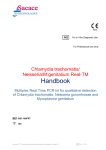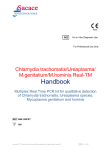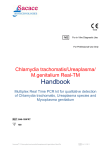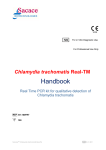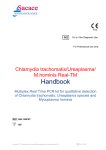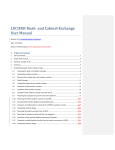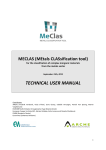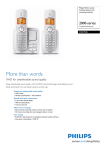Download zur Testdurchführung nur die lotspezifische
Transcript
DUPLIC α RealTime GC/CT/TV/MG Kit h: EBR161100 – 100 tests CV INTENDED USE Duplica Real Time GC/CT/TV/MG Kit is a multiplex Real Time PCR test for the qualitative detection of Neisseria gonorrhoeae, Chlamydia trachomatis, Trichomonas vaginalis and Mycoplasma genitalium in the urogenital swabs, urine, prostatic liquid and other biological materials. SUMMARY STDs (sexually transmitted diseases) refer to a variety of bacterial, viral and parasitic infections that are acquired through sexual activity. Some STDs, such as syphilis and gonorrhea, have been known for centuries while others, such as HIV, have been identified only in the past few decades. STDs are caused by more than 25 infectious organisms. As more organisms are identified, the number of STDs continues to expand. Common STDs include: chlamydia, gonorrhea, herpes, HIV, HPV, syphilis, gardnerella and trichomoniasis. The development of tests based on nucleic acid amplification technology has been the most important advance in the field of STD diagnosis. Because nucleic acid amplification is exquisitely sensitive and highly specific, it offers the opportunity to use noninvasive sampling techniques to screen for infections in asymptomatic individuals who would not ordinarily seek clinical care. PRINCIPLE OF THE TEST N.gonorrhoeae/C.trachomatis/T.vaginalis/M.genitalium detection by the multiplex polymerase chain reaction (PCR) is based on the amplification of pathogen genome specific region using specific N.gonorrhoeae/C.trachomatis/T.vaginalis/M.genitalium primers. In realtime PCR, the amplified product is detected using fluorescent dyes. These dyes are linked to oligonucleotide probes which bind specifically to the amplified product during thermocycling. The real-time monitoring of the fluorescence intensities during the real-time PCR allows the detection of accumulating product without re-opening the reaction tubes after the PCR run. Duplica Real Time GC/CT/TV/MG Kit is a qualitative test that contains the Extraction Amplification Control (EAC. It must be used in the extraction procedure in order to control the extraction process of each individual sample and to identify possible reaction inhibition. Duplica Real Time GC/CT/TV/MG Kit uses “hot-start”, which greatly reduces frequency of nonspecifically primed reactions. “Hot-start” is guaranteed by chemically modified Taq polymerase, which is activated by heating at 95ºC for 15 min. REAGENTS PROVIDED Reagent Oligo Mix (OM) Description or Color code Volume, ml Quantity colorless clear liquid 1.1 1 tube Amplification Mix (AM) colorless clear liquid 0.6 2 tubes Taq polymerase (TAQ) colorless clear liquid 0.06 2 tubes Positive Control (C+) colorless clear liquid 0.2 1 tube Reaction Blank (BM) colorless clear liquid 0.5 1 tube Extraction Negative Control (ENC)* colorless clear liquid 1.2 1 tube Extraction Amplification Control (EAC)** colorless clear liquid 1.0 1 tube * must be used in the extraction procedure as Negative Control of Extraction and treated as a sample. ** add 10 µl of Extraction Amplification Control during the DNA extraction procedure directly to the sample/lysis buffer mixture (see herein at the paragraph “DNA isolation” and refer to specific kit’s protocol). STORAGE AND HANDLING All components of the Duplica Real Time GC/CT/TV/MG (except for Taq polymerase and Amplification Mix) must to be stored at the temperature 2–8ºC when not in use. All components of the Duplica Real Time GC/CT/TV/MG are stable until the expiration date. The shelf life of reagents before and after the first use is the same, unless otherwise stated. Oligo Mix (OM) must be kept away from light. Taq polymerase (TAQ) and Amplification Mix (AM) must be stored at ≤ –16 C STABILITY Duplica Real Time GC/CT/TV/MG is stable up to the expiration date indicated on the kit label. The product will maintain performance through the control date printed on the label. The shelf life of reagents before and after the first use is the same, unless otherwise stated. Exposure to light, heat or humidity may affect the shelf life of some of the kit components and should be avoided. Repeated thawing and freezing of these reagents should be avoided, as this may reduce the sensitivity. REAGENTS REQUIRED BUT NOT SUPPLIED 1. DNA extraction kit. 2. Transport medium 3. Disposable powder-free gloves 4. Pipettes (adjustable) 5. Sterile pipette tips with aerosol barriers up to 200 µl 6. Tube racks 7. Vortex mixer 8. Desktop centrifuge with rotor for 2 ml reaction tubes 9. PCR box 10.Real Time PCR instrument 11.Disposable polypropylene microtubes for PCR or PCR-plate 12.Refrigerator for 2–8 °C 13.Deep-freezer for ≤ –16 C 14.Waste bin for used tips QUALITY CONTROL In accordance with EuroClone Diagnostica’s ISO 13485-Certified Quality Management System, each lot is tested against predetermined specifications to ensure consistent product quality. PRODUCT USE LIMITATIONS All reagents may exclusively be used in in vitro diagnostics. Use of this product should be limited to personnel trained in the techniques of DNA amplification (EN375). Strict compliance with the user manual is required for optimal PCR results. Attention should be paid to expiration dates printed on the box and labels of all components. Do not use a kit after its expiration date. PRECAUTIONS AND WARNINGS In Vitro Diagnostic Medical Device For In Vitro Diagnostic Use Only 1. 2. 3. 4. 5. 6. 7. 8. 9. 10. 11. 12. 13. Wear disposable gloves, laboratory coats and eye protection when handling specimens and reagents. Thoroughly wash hands afterward Do not pipette by mouth Do not eat, drink, smoke, apply cosmetics, or handle contact lenses in laboratory work areas. Do not use a kit after its expiration date Dispose of all specimens and unused reagents in accordance with local regulations Biosafety Level 2 should be used for materials that contain or are suspected of containing infectious agents Clean and disinfect all spills of specimens or reagents using a disinfectant such as 0,5% sodium hypochlorite, or other suitable disinfectant Avoid contact of specimens and reagents with the skin, eyes and mucous membranes. If these solutions come into contact, rinse immediately with water and seek medical advice immediately Material Safety Data Sheets (MSDS) are available on request. Use of this product should be limited to personnel trained in the techniques of DNA amplification PCR reactions are sensitive to contamination. Measures to reduce the risk of contamination in the laboratory include physically separating the activities involved in performing PCR in compliance with good laboratory practice Workflow in the laboratory must proceed in a uni-directional manner, beginning in the Extraction Area and moving to the PCR and Detection Area. Do not return samples, equipment and reagents in the area where you performed previous step Some components of this kit contain sodium azide as a preservative. Do not use metal tubing for reagent transfer. Sampling of biological materials for PCR-analysis, transportation, and storage are described in details in the handbook of the manufacturer. It is recommended that this handbook is read before beginning of the work. OPERATING PROCEDURE a) Sample collection, storage and transport Duplica Real Time GC/CT/TV/MG can analyze DNA extracted from: 1. cervical, urethral, conjunctival swabs: insert the swab into the nuclease-free 1,5 ml tube and add 0,2 ml of Transport medium (can be ordered separately, EuroClone Diagnostica Ref K12-Stab). Vigorously agitate swabs for 15-20 sec. 2. urine sediment: collect 10-20 ml of first-catch urine in a sterile container. Centrifuge for 30 min at 3000 x g, carefully discard the supernatant and leave about 200 µl of solution. Resuspend the sediment. Use the suspension for the DNA extraction. 3.prostatic liquid stored in “Eppendorf” tube; 4. seminal liquid: maintain semen for 40 min in darkness until liquefaction. Use 100 µl for the DNA extraction. 5. It is recommended to process samples immediately after collection. Store samples at 2–8 °C for no longer than 24 hours, or freeze at –20/80°C. Transportation of clinical specimens must comply with country, federal, state and local regulations for the transport of etiologic agents. b) DNA extraction Any commercial DNA isolation kit, if IVD-CE validated for the specimen types indicated herein at the “Intended Use” paragraph, could be used. EuroClone Diagnostica recommends to use Duplica Prep Body Fluid kit (ref. EDI004200) for automatic extraction and Bact Extra Pure Kit (EDR004050) for manual extraction. Please carry out the DNA extraction according to the manufacturer’s instructions. Add 10 μl of Extraction Amplification Control (EAC) during the DNA isolation procedure directly to the sample/lysis buffer mixture. c) Thermal Cycler set up Refer to the specific handbook of the equipment used to set the following thermal profile. We recommend to switch on the instrument, setting the thermal profile and having the plate ready before preparing the reaction mix. Thermal Profile Step Hold Cycling 1 Cycling 2 Temperature, °C Time Cycle repeats 95 15 min 1 95 5s 60 20 s 72 15 s 95 5s 60 20 s (fluorescence detection) 72 15 s 5 40 Fluorescence is detected at the 2nd step of Cycling 2 stage (60°C) in FAM/Green, JOE/Yellow/HEX/Cy3, ROX/Orange/Texas Red, Crimson and Cy5/Red fluorescence channels d) Preparation of PCR mix The total reaction volume is 25 µl; the volume of DNA sample is 10 µl. 1. Prepare required quantity of reaction tubes for samples (N) and controls (N+2). 2. Prepare in the new sterile tube 10*(N+3) µl of Oligo Mix , 5*(N+3) µl of Amplification Mix and 0,5*(N+3) µl of Taq polymerase. Vortex and centrifuge briefly. 3. Add to each tube 15 µl of Reaction Mix and 10 µl of extracted DNA. Mix by pipetting. 4. Unfreeze Amplification Mix before mixing. 5. 6. Prepare for each panel 2 controls: 7. add 10 µl of Reaction Blank 8. add 10 µl of Positive Control 9. Insert the tubes (or the plate) in the thermal-cycler. e) INSTRUMENT SETTINGS Rotor-Gene 6000/Q Make the adjustment of the fluorescence channel sensitivity: Channel Setup → Gain Optimisation → Auto Gain Optimisation Setup →Optimise Acquiring and select Perform Optimisation Before 1-st Acquisition. For Green channel indicate Min Reading 5, Max Reading 10 and for Yellow, Orange, Red, Crimson channels Min Reading 4, Max Reading 8. In the column Tube position program position of the tubes in the carousel of the Rotor-Gene (the 1st position must contains reaction tube with reagents). Close the window Auto Gain Calibration Setup f) ANALYSIS and INTERPRETATION of the RESULTS 1. 2. 3. 4. 5. Neisseria gonorrhoeae is detected on the Green channel Chlamydia trachomatis is detected on the Yellow channel Mycoplasma genitalium is detected on the Orange channel Trichomonas vaginalis is detected on the Crimson Extraction Amplification Control (EAC is detected on the Red channel 1. The results are interpreted with the software of Rotor-Gene through the presence of crossing of fluorescence curve with the threshold line. Neisseria gonorrhoeae is detected on the Green channel, Chlamydia trachomatis on the Yellow channel, Mycoplasma genitalium on the Orange channel, Trichomonas vaginalis on Crimson and IC DNA on the Red channel. 2. Press Analysis then select button Quantitation. Perform the operation for the channel Green (Cycling A. Green), then for the channels Yellow (Cycling A. Yellow), Orange (Cycling A.Orange), Red (Cycling A.Red) and Crimson (Cycling A.Crimson). 2.1. Data analysis of Neisseria gonorrhoeae DNA 1. Click Green channel on the curve. 2. Select the Dynamic tube button in the main window menu. 3. In CT Calculation menu set Threshold = 0.1. 4. Select Outlier Removal button and type 0 in the text field. 5. The Ct (Threshold cycle) values for each sample in channel will be shown in the results grid. 2.2. Data analysis of Chlamydia trachomatis DNA 1. Click Yellow channel on the curve. 2. Select the Dynamic tube button in the main window menu. 3. In CT Calculation menu set Threshold = 0.1. 4. Select Outlier Removal button and type 5 in the text field. 5. The Ct (Threshold cycle) values for each sample in channel will be shown in the results grid. 2.3. Data analysis of Mycoplasma genitalium DNA 1. Click Orange channel on the curve. 2. Select the Dynamic tube button in the main window menu. 3. In CT Calculation menu set Threshold = 0.1. 4. Select Outlier Removal button and type 5 in the text field. 5. The Ct (Threshold cycle) values for each sample in channel will be shown in the results grid. 2.4. Data analysis of Trichomonas vaginalis DNA 1. Click Crimson channel on the curve. 2. Select the Dynamic tube button in the main window menu. 3. In CT Calculation menu set Threshold = 0.1. 4. Select Outlier Removal button and type 10 in the text field. 5. The Ct (Threshold cycle) values for each sample in channel will be shown in the results grid. 2.5. Data analysis of the Extraction Amplification Control (EAC) 1. Click Red channel on the curve. 2. Select the Dynamic tube button in the main window menu. 3. In CT Calculation menu set Threshold = 0.07. 4. Select Outlier Removal button and type 5 in the text field. The results are interpreted by the device software by the crossing (or not crossing) of the fluorescence curve with the threshold line. The results of the analysis are reliable only if the results obtained for both Positive and Negative Controls are correct. Refer to the here below Run validation Table. Run validation Table Control Ct Green Ct Yellow Ct Orange Ct Crimson DNA isolation Neg Neg Neg Neg <33 Valid result Reaction Blank Amplification Neg Neg Neg Neg Neg Valid result Positive Control Amplification <35 <35 <35 <35 <33 Valid result ENC Stage for control Ct Red Interpretation If the above conditions have been met the run is valid and it is possible to analyze the data following the here below instructions: The Ct (Threshold cycle) values for each sample in channel will be shown in the results grid. The sample is considered to be positive for Neisseria gonorrhoeae if its Ct value is defined in the results grid (the fluorescence curve 1. crosses the threshold line) in the Green channel. 2. The sample is considered to be positive for Chlamydia trachomatis if its Ct value is defined in the results grid (the fluorescence curve crosses the threshold line) in the Yellow channel. 3. The sample is considered to be positive for Mycoplasma genitalium if its Ct value is defined in the results grid (the fluorescence curve crosses the threshold line) in the Orange channel. 4. The sample is considered to be positive for Trichomonas vaginalis if its Ct value is defined in the results grid (the fluorescence curve crosses the threshold line) in the Crimson channel. 5. The sample is considered to be negative for Chlamydia trachomatis, Neisseria gonorrhoeae, Mycoplasma genitalium and Trichomonas vaginalis if its Ct value is not defined in the results grid (the fluorescence curve does not cross the threshold line) in Green, Yellow, Orange and Crimson channels and the Ct value does not exceed the boundary value in the results grid in the Red channel (Ct<33). QUALITY CONTROL PROCEDURE A defined quantity of Extraction Amplification Control (EAC) is introduced into each sample and control at the beginning of sample preparation procedure in order to control the extraction process of each individual sample and to identify possible reaction inhibition. Extraction Negative Control, Reaction Blank, Positive control are required for every run to verify that the specimen preparation, the amplification and the detection steps are performed correctly. If the controls are out of their expected range (see table Results for Controls), all of the specimens and controls from that run must be processed beginning from the sample preparation step. SPECIFICATIONS Sensitivity The analytical sensitivity for Neisseria gonorrhoeae, Chlamydia trachomatis, Mycoplasma genitalium, and Trichomonas vaginalis DNA is not less than 5x102 genome equivalents per 1 ml of sample (GE/ml). The analytical sensitivity of each microorganism does not change even if two other microorganisms are present at high concentrations. Specificity The analytical specificity of Duplica Real Time GC/CT/TV/MG Kit is ensured by selection of specific primers and probes as well as stringent reaction conditions. The primers and probes were checked for possible homologies to all sequences published in gene banks by sequence comparison analysis. The clinical specificity of Duplica Real Time GC/CT/TV/MG Kit was confirmed in laboratory clinical trials. TROUBLESHOOTING Problem 1: Weak or no signal of the Extraction Amplification Control (Red channel) for the Extraction Negative Control. 1. The PCR was inhibited. Make sure that you use a recommended DNA extraction method and follow to the manufacturer’s instructions. 2. The reagents storage conditions didn’t comply with the instructions. Check the storage conditions 3. Improper DNA extraction. Repeat analysis starting from the DNA extraction stage 4. The PCR conditions didn’t comply with the instructions. Check the PCR conditions and select for the the Extraction Amplification Control detection the fluorescence channel reported in the protocol. 5. The Extraction Amplification Control was not added to the sample during the pipetting of reagents. Make attention during the DNA extraction procedure. Problem 2: Weak or no signal of the Positive Control. 1. The PCR conditions didn’t comply with the instructions. Check the amplification protocol and select the fluorescence channel reported in the manual. Problem 3: Any signal on Extraction Negative Control (except for Red channel). 1. Contamination during DNA extraction procedure. All samples results are invalid. Decontaminate all surfaces and instruments with sodium hypochlorite and ethanol. Use only filter tips during the extraction procedure. Change tips between tubes. Repeat the DNA extraction with the new set of reagents. Problem 4: Any signal with Reaction Blank. 1. Contamination during PCR preparation procedure. All samples results are invalid. Decontaminate all surfaces and instruments with sodium hypochlorite and ethanol or special DNA decontamination reagents. Pipette the Positive control at last. Repeat the PCR preparation with the new set of reagents. REFERENCES. 1. Role of Chlamydia trachomatis in Miscarriage. Baud D, Goy G, Jaton K, Osterheld MC, Blumer S, Borel N, Vial Y, Hohlfeld P, Pospischil A, Greub G. Emerg Infect Dis. 2011 Sep;17(9):1630-5. 2. Molecular Diagnosis of Genital Chlamydia trachomatis Infection by Polymerase Chain Reaction. Khan ER, Hossain MA, Paul SK, Mahmud MC, Rahman MM, Alam MA, Hasan MM, Mahmud NU, Nahar K. Mymensingh Med J. 2011 Jul;20(3):362-5. 3. Chlamydia trachomatis prevalence in unselected infertile couples.Salmeri M, Santanocita A, Toscano MA, Morello A, Valenti D, La Vignera S, Bellanca S, Vicari E, Calogero AE. Syst Biol Reprod Med. 2010 Dec;56(6):450-6. Epub 2010 Sep 17. 4. Urine-based testing for Chlamydia trachomatis among young adults in a population-based survey in Croatia: feasibility and prevalence. Božičević I, Grgić I, Židovec-Lepej S, Čakalo JI, Belak-Kovačević S, Štulhofer A, Begovac J. BMC Public Health. 2011 Apr 14;11:230. 5. Frequency of Chlamydia trachomatis, Neisseria gonorrhoeae, Mycoplasma genitalium, Mycoplasma hominis and Ureaplasma species in cervical samples. Rodrigues MM, Fernandes PÁ, Haddad JP, Paiva MC, Souza Mdo C, Andrade TC, Fernandes AP. J Obstet Gynaecol. 2011;31(3):237-41. 6. Prevalence of Chlamydia trachomatis: results from the first national population-based survey in France. Goulet V, de Barbeyrac B, Raherison S, Prudhomme M, Semaille C, Warszawski J; CSF group. Sex Transm Infect. 2010 Aug;86(4):263 7. Evaluation of a new multiplex polymerase chain reaction assay STDFinder for the simultaneous detection of 7 sexually transmitted disease pathogens. Muvunyi CM, Dhont N, Verhelst R, Crucitti T, Reijans M, Mulders B, Simons G, Temmerman M, Claeys G, Padalko E. Diagn Microbiol Infect Dis. 2011 Sep;71(1):29-37. Epub 2011 Jul 27 8. Urine-based testing for Chlamydia trachomatis among young adults in a population-based survey in Croatia: feasibility and prevalence. Božičević I, Grgić I, Židovec-Lepej S, Čakalo JI, Belak-Kovačević S, Štulhofer A, Begovac J. BMC Public Health. 2011 Apr 14;11:230. “THE PURCHASE OF THIS PRODUCT GRANTS THE PURCHASER RIGHTS UNDER CERTAIN ROCHE PATENTS TO USE IT SOLELY FOR PROVIDING HUMAN IN VITRO DIAGNOSTIC SERVICES. NO GENERAL PATENT OR OTHER LICENSE OF ANY KIND OTHER THAN THIS SPECIFIC RIGHT OF USE FROM PURCHASE IS GRANTED HEREBY” PI EBR16100 - R0 - 04-2013 * Rotor-Gene™ Technology is a registered trademark of Qiagen PI-EBR161100/r0/0413/1










